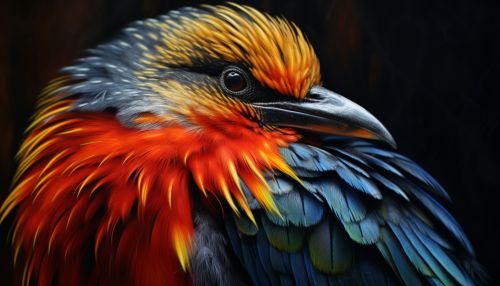Bird anatomy
Introduction
Birds, members of the class Aves, are a group of endothermic vertebrates characterized by feathers, toothless beaked jaws, the laying of hard-shelled eggs, a high metabolic rate, a four-chambered heart, and a strong yet lightweight skeleton. The study of bird anatomy, involving the physical structure and function of birds' bodies, offers insight into how they are able to achieve feats such as flight and migration.
External Anatomy
Feathers
Feathers are the defining characteristic of Aves, found on every living species of bird. They serve multiple functions including flight, thermal regulation, waterproofing, and visual signaling. Feathers are made of keratin, a fibrous protein also found in hair, nails, and scales.
Beak
The beak, or bill, of a bird is primarily used for eating, grooming, manipulating objects, killing prey, probing for food, courtship, and feeding young. The size, shape, and color of beaks vary significantly between species, reflecting a wide range of dietary and behavioral adaptations.
Legs and Feet
Bird legs and feet also exhibit a great deal of variation, related to the wide variety of bird lifestyles. For instance, birds that spend much of their time walking or running on the ground have long, strong legs, while birds that perch on branches have flexible toes with sharp claws.
Internal Anatomy
Skeletal System
The bird skeletal system is highly adapted for flight. It is extremely lightweight but strong enough to withstand the stresses of taking off, flying, and landing. One key adaptation is the fusing of bones into single ossifications, such as the pygostyle.
Respiratory System
The avian respiratory system delivers oxygen from the air to the tissues and also removes carbon dioxide. In addition, the respiratory system plays an important role in thermoregulation (keeping the bird's body temperature steady).
Digestive System
The bird's digestive system is a highly efficient, two-part system that allows birds to eat a variety of foods, including those that are hard to digest. The first part, the glandular stomach or proventriculus, secretes digestive enzymes to break down food. The second part, the muscular stomach or gizzard, grinds up food, often with the aid of ingested stones or grit.
Reproduction
Birds have a unique reproductive system, with only the left ovary being functional in the majority of species. The egg, produced by the ovary, passes through the oviduct, receiving layers of albumen, shell membranes, and the shell as it goes.
Flight
Bird flight is one of the most complex forms of locomotion in the animal kingdom. Each facet of this type of movement, including hovering, taking off, and landing, involves many complex movements.
See Also


